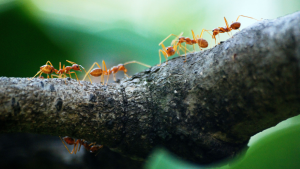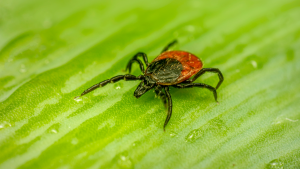One of the biggest lies ever told was that something could be “as harmless as a fly!” Flies are one of the deadliest species on Earth – resulting in millions of deaths each year alone.
Throughout human history flies’ infamy has been well documented. Beelzebub – another name for the Devil in Hebrew – is the Lord of the Flies. Ancient Jews developed the Mosaic Code, a set of sanitary guidelines which ascertained prevention of disease was more effective than remedial action. The Mosaic Code laid the groundwork for modern sanitation methods, like: taking out garbage and disposing it away from cities, sanitary meat-processing (Kosher), AND recognizing flies were carrying the diseases. Many other cultures have also condemned flies as symbols/harbingers of evil & death.
Flies carry many of the deadliest diseases known to man, including but not limited to: malaria, yellow fever, dysentery, sleeping sickness, typhoid, many parasitic worms, E. coli, salmonella, and even anthrax.
There is well documented resistance to harmful chemicals among flies, that includes many “name-brand” and registered poisons: permethrin, pyrethrin, pyrethroids, and others.
Luckily, keeping flies from entering homes & getting rid of them is rather simple AND can be done with non-toxic, natural/organic alternatives!
Table of Contents:
General Fly Biology & Behavior
Non-Toxic Methods
Final Thoughts
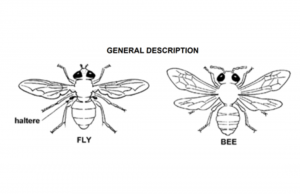
General Fly Biology & Behavior
The above illustration depicts the common housefly and honeybee. Flies have notably different anatomical features from other insects, they only have 2 wings, have 2 small “haltere” which are little stubs directly behind their set of wings that aid in flight, and can have noticeably smaller antennae (at least with common houseflies).
There are over 120,000 different species of flies but only a very select few are considered serious pests: houseflies, cluster flies, little houseflies, vinegar or fruit flies, and blow flies; this article will focus on all of these specific types.
An identification chart for each fly type is as follows:
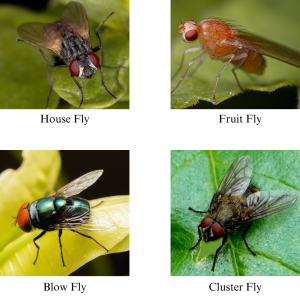
One single garbage can is able to produce more than 1,000 flies & 2,000 maggots in a single week! This is due to their relatively short life cycle that is comprised of 4 different stages: egg, larva, pupa, and adult.
Each fly type feeds on a specific food source:
House Fly & Little House Fly = garbage or manure
Cluster Fly = adults feed on fruits & flowers, larva parasitize earthworms
Fruit Fly = any fermenting material, including: fruit, vegetables, beer, and rotting pet food. In addition any fermenting water from: refrigerators, humidifiers, sink drains, and sour mops & rags.
Blow Fly = dead animals, meat scraps in garbage, and wet mixed garbage
The #1 way to control any fly infestation is to remove their food source. As noted above, flies are attracted to rotting/decaying food & garbage, simply eliminating these rotting items will go a long way in the prevention of flies. Flies are generally a symptom of an ongoing problem, i.e. the rotting materials they eat and lay their eggs in.
Non-Toxic Methods
There are many safe ways to get rid of flies that actually work quickly. Each of the 5 fly types discussed above share the same control methods, but there are some unique methods to each.
General Fly Control
Sanitation & cleanliness is the best way to control all fly infestations. Although the adult flies are the main carriers of disease, it is more important to focus on eliminating their eggs. If you stop the eggs, you will stop all other life stages of the fly.
Doing a monthly cleaning of your garbage can or dumpster will help to prevent MILLIONS of flies. It is important to select a natural cleaner & pest control spray that will be safe for you & your loved ones, and effectively control flies without increasing their resistance.
TweetMint® Enzyme Cleaner provides a thorough deep clean, that removes stains & odor-causing bacteria at the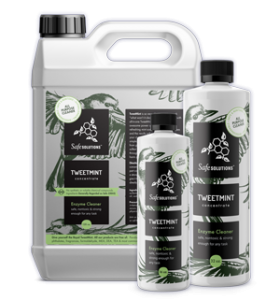 microscopic level. TweetMint® can eliminate the fly breeding sites and help to repel them with its refreshing peppermint scent. You can also spray flies, maggots, and eggs directly with TweetMint® to control them; try using 1 oz per 32 oz of water.
microscopic level. TweetMint® can eliminate the fly breeding sites and help to repel them with its refreshing peppermint scent. You can also spray flies, maggots, and eggs directly with TweetMint® to control them; try using 1 oz per 32 oz of water.
By keeping your home tidy & clean, virtually all flies will be controlled, as they need rotting or fermenting material to survive!
Fruit Flies
Fruit flies are incredibly weak fliers, their slender bodies & flimsy wings are susceptible to mild gusts of wind. One of the simplest methods to keeping all fruit flies away from fruit is running a fan (which can be small or medium sized), 24/7 for a few weeks, on infested fruit. The flies will not have access to the fruit to lay their eggs and will be denied access to food.
A non-toxic bait station that can be made for fruit flies is as follows:
Make a mixture of 7 parts water to 1 part cider vinegar. Place a few drops of soap or better yet TweetMint® Enzyme Cleaner in the mixture. Pour the mixture into baby food jars or small glasses. The fruit flies will drown, and simply replace as needed.
Cluster Flies
Cluster flies will amass large swarms in the Fall and invade homes in incredibly large numbers, as they seek warm places to survive the cold winter months.
Sometimes a child or someone else in the home can accidentally leave a door or window open, letting in many swarms of flies.
A very simple way to eliminate ALL of the flies is to turn off all lights but one. Place a bowl of soapy water beneath the light, preferably using a few drops of TweetMint® Enzyme Cleaner. In the following morning, most if not all of the flies will be drowned in the bowl.
Blow Flies
Pet droppings are a very common food source & breeding/egg-laying site for blow flies. By simply feeding 1 teaspoon of food-grade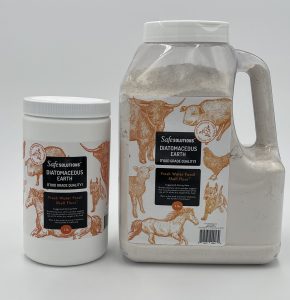 diatomaceous earth (DE) in each pet’s meal, their dropping will become inhabitable for fly larva. The DE will remain in the droppings and eliminate any larva that emerge from their eggs.
diatomaceous earth (DE) in each pet’s meal, their dropping will become inhabitable for fly larva. The DE will remain in the droppings and eliminate any larva that emerge from their eggs.
Final Thoughts
Focus on controlling the fly eggs, and you will easily control any fly infestation. Flies are only invading your home or business because there is rotting garbage, food, or dead animals attracting them to eat & lay their eggs.
By removing the rotting material, virtually all fly problems will cease. It is very important to have a tough non-toxic cleaner and implement a regular cleaning regimen. TweetMint® Enzyme Cleaner is perfect for eliminating & repelling flies, as well as fully & safely removing any food or breeding source.
If you would like to learn more in-depth control methods for flies, read more by visiting the free online manual, the Best Control II. Click here: www.thebestcontrol2.com
If you would like to learn more or purchase TweetMint®, click here: https://www.safesolutions.com/product/tweetmint-enzyme-cleaner/
Want to learn more about free & safe pest control methods? Keep checking in for more Bug Blogs or read some of our other articles below!
– Gage


